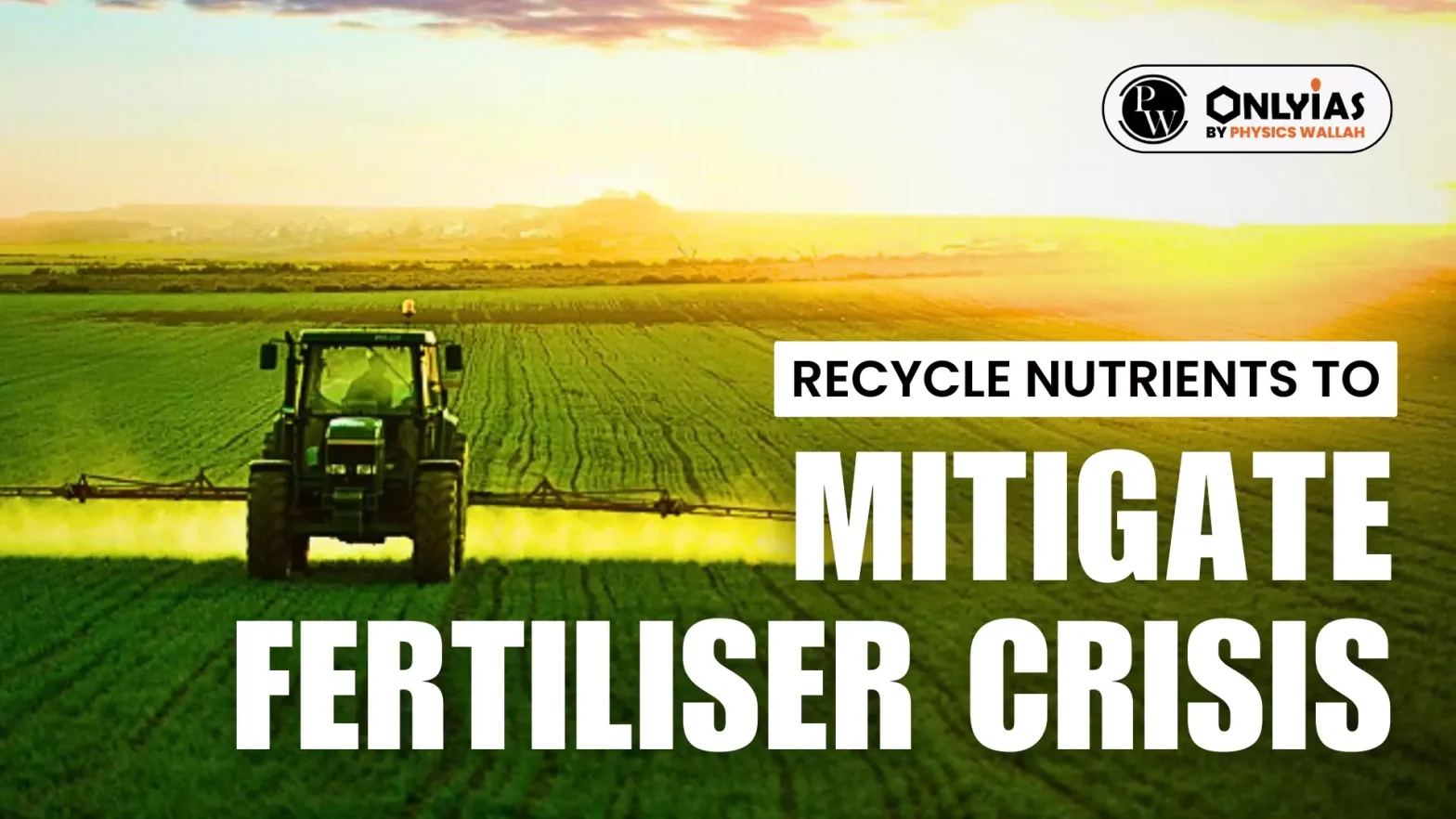Many elements crucial for life on Earth are depleting rapidly due to disrupted biogeochemical cycles caused by human activities.
Recycle Nutrients to Mitigate Fertiliser Crisis
- Impact of Human Activity: If you think carbon is bad enough, other essential elements that sustain life on Earth are also crossing the planetary boundaries of sustainability, as their natural ‘biogeochemical’ cycles are broken by human activities.
- Traditional Farming Practices: For about ten thousand years before the ‘green’ revolution, farmers grew crops without fertilizers by combining legume-based crop rotations and livestock farming.
- Legume crops and some soil microbes fixed atmospheric nitrogen, while livestock manure and urine enriched the soil with nutrients such as compounds of nitrogen (N), phosphorus (P), potassium (K), sulfur (S), carbon (C) and even micronutrients.
- Modern Farming: But modern cropping in India shifted away from legume-based crop rotations and relies heavily on NPK fertilisers rather than manures, costing the Indian govt over Rs. 2 lakh crores per year in subsidy.
- Impact of Livestock Farming: As livestock farming moved away from crops and intensified as peri-urban dairies, manure and urine mostly found their way to our ground and surface water bodies.
- The release of untreated dairy or domestic and other wastes has reduced the Sahibi River in New Delhi to a wastewater drain (Nazafgarh drain), which along with the Shahdara drain heavily pollutes the river Yamuna, apart from releasing noxious gases into the air.
Enroll now for UPSC Online Course
- Tackling Nutrient Pollution: The nutrient cycles have thus become cascades causing nutrient pollution, but the good news is that some pollutants are nutrients in the wrong place and can be brought back.
- Utilization of Fertilizers: Unfortunately, less than 30 percent of the fertiliser nutrients supplied as fertilizers are harvested as crop yield and the remaining add to the growing pollution.
- Environmental Impacts of Nutrients:
- In water bodies, the accumulation of these nutrients supports unwanted algal growth causing eutrophication and death of fish and other useful aquatic and marine species.
- This destroys the ecosystem and the livelihoods of people who depend on fishing, tourism and other ecosystem services.
- In our coastal areas, algal eutrophication progressively causes green tides, brown and eventually red tides and even the accumulation of poisonous species.
- The reversal of these trends can rebuild water economies and support the livelihoods of millions.
- Air Pollution: Nitrogenous compounds from fertilisers, manures, urine and sewage also cause air pollution as ammonia or nitrous oxide.
- Ammonia contributes heavily to particulate matter pollution (PM2.5 and PM5) by combining with NOx gases (nitrogen dioxide and nitric oxide) emitted from fuel or residue burning for power, transport industry, or waste disposal.
- Over a million deaths per year are attributed to PM2.5 alone in India, while some attribute up to 7 per cent of all deaths to PM2.5, as India has the largest number of the world’s most polluted cities in terms of PM2.5.
Way Forward
- Restoring Nutrient Cycle: These figures call for drastic measures to control air pollution in general and PM2.5 in particular, but it needs not only curbing pollution from fuel burning but also restoring the nutrient cycles in agriculture and waste management.
- Potential of Manure Recycling: While a fraction of livestock manure is recycled for cropping in India, urine recycling is nearly nonexistent.
- If we recycled all the 15 kg per animal per day of manure produced by 200 million cattle, its 5 per cent NPK nutrients amount to 1,50,000 metric tons.
- This is much more than our average daily fertilizer consumption, which is about 1,37,000 metric tons. Add to this about 3 percent of nutrients lost from 15-20 litres of cattle urine per animal per day totalling 1,20,000 metric tons.
- Global Best Practices: Technologies and best practices are available from Europe and elsewhere to maximise nutrient retention and recycling from manure and urine.
- Benefits of Farmyard Manure: We already know that at least half of the currently recommended fertiliser doses can be replaced with farmyard manure without any loss of crop yield.
- It not only saves a lakh crores but also reduces the environmental footprint of fertilisers, manures and agriculture itself.
- Low Wastewater Treatment Capacity: Similarly, over 55,000 metric tonnes of nutrients equivalent to 40 percent of our fertilizer consumption are lost daily from over 150 billion litres of wastewater produced per day in India. This is because of our abysmally low wastewater treatment capacity of about 27 per cent.
- Enhancing Sewage Treatment Plants: Most sewage treatment plants (STPs) exist only in the cities and only a few of them work.
- Fortunately, some metropolitan cities like Delhi and Hyderabad are rapidly expanding their STP capacity to become 100 per cent wastewater treatment capable in a year or two and some other big cities in India are following suit.
Check Out UPSC NCERT Textbooks From PW Store
![]() 3 Jun 2024
3 Jun 2024

